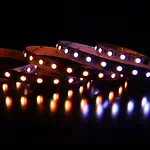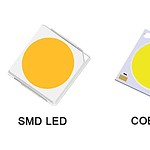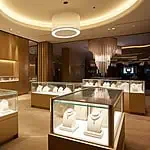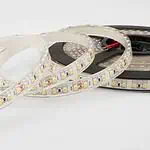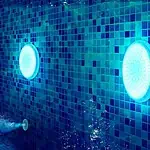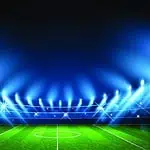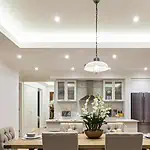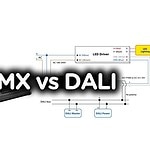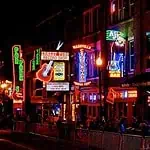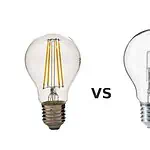The outdoor light fixtures have to go through adverse weather conditions like dust, rain, wind, and more. In this case, considering whether you need a weatherproof light or one with waterproofing is essential. But in most cases, you may get confused between the two terms as they are often used synonymously. Therefore, knowing the difference is a must!
The main difference between weatherproof and waterproof is their degree of protection against moisture or water. Weatherproof fixtures resist dust, rain, water splash, UV rays, and other weather conditions. But they are not entirely sealed to use underwater. In contrast, waterproof lights have a more robust construction. They can resist water entrance inside, even when submerged. And so these lights are used inside swimming pools, boats, marine lighting, etc.
In this article, I’ve compared weatherproof and waterproof light fixtures side-by-side to highlight their differences. This will surely help you choose the right one for your project. So, let’s begin the discussion-
What Is Weatherproof?
Weatherproof lights refer to fixtures that can withstand usual weather conditions. These lights can resist rain, wind, sunlight, and temperature fluctuations. For these reasons, these lights are used for outdoor lighting. You can use them on the garden, patio, building facade, or outdoors in restaurants, shopping malls, hospitals, etc. They can bear water splash but aren’t suitable for submerged or prolonged exposure to water. So, you must not use them for fountains, pools, or other areas where fixtures continuously come in direct water contact.
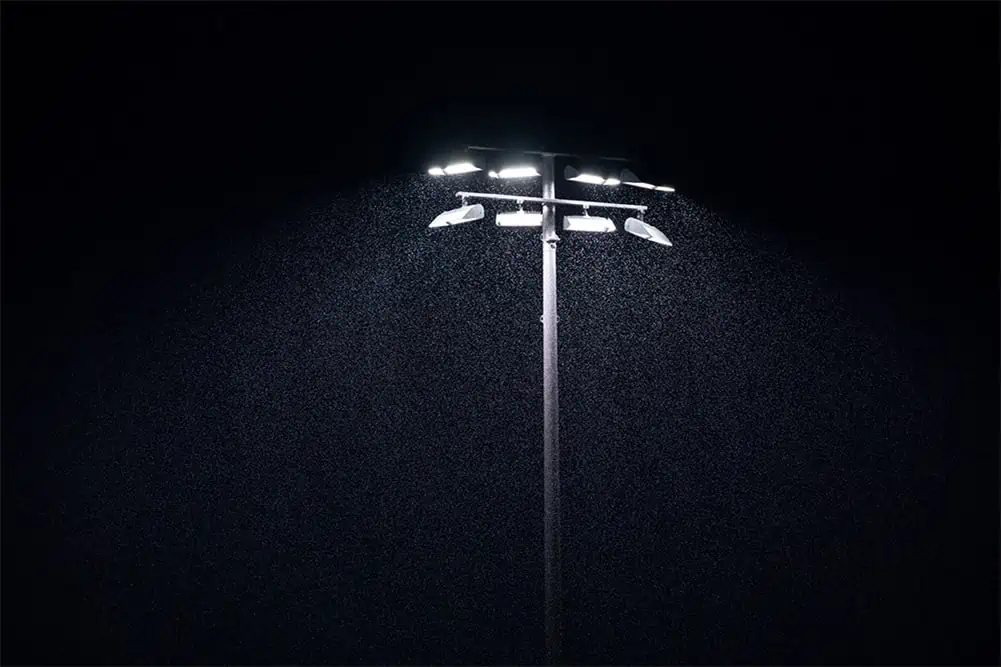
What Is Waterproof?
Waterproof lights are completely sealed and protected from water and moisture content. These light fixtures have a higher IP rating. Waterproof lights are often used in industrial areas with higher moisture content. The worth-mentioning feature of these light fixtures is that they can withstand submerged water. So, the lights you see on swimming pools, fountains, and underwater areas are all waterproof fixtures. To learn more about waterproof lighting, check this- A Guide to Waterproof LED Strip Lights.
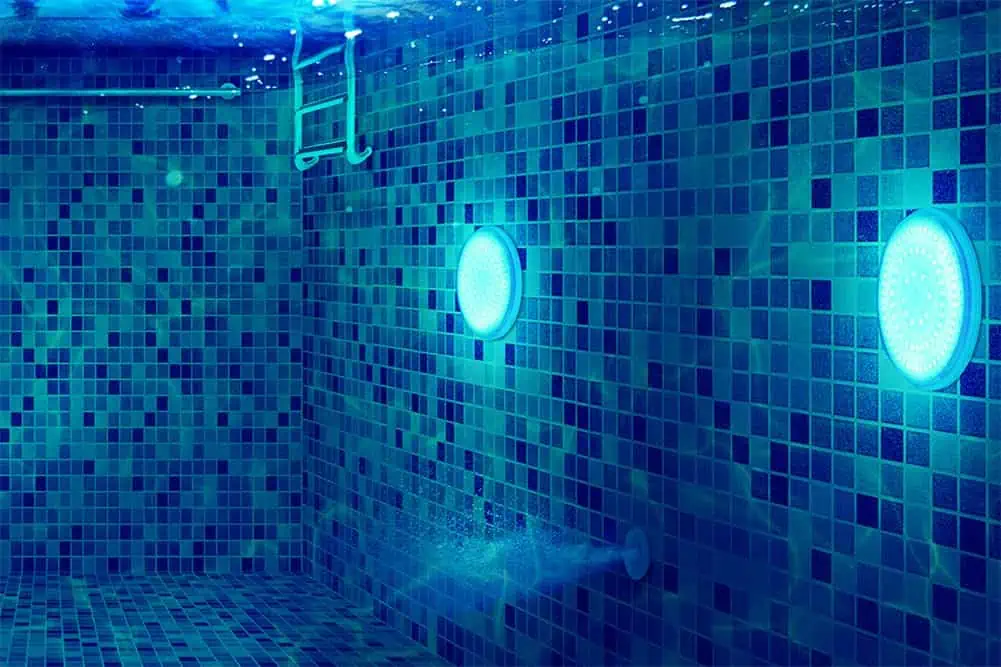
Weatherproof Vs. Waterproof Light Fixture: The Differences
| Weatherproof VS. Waterproof: Quick Differentiating Chart | ||
| Criteria | Weatherproof | Waterproof |
| Protection Against | Light rain, water splash, dust, wind, and regular weather conditions | Excessive moisture, submerged condition/underwater |
| Coating | Powder coating, painting, stainless steel or corrosion-resistant aluminum | Epoxy resin, PU glue, Silicone |
| Application | Outdoor lighting of commercial and residential spaces Pathway lighting Landscape Entryway lighting Outdoor signage lights | Swimming pool lighting Boat lighting Marine lighting Underwater areas Industrial lighting |
| IP Rating | IP44 to IP66 or higher | IP67 and IP68 |
| Price | The price is lower than waterproof lights | Expensive than weatherproof lights |
The chart above has given you an idea about the differences between weatherproof and waterproof light. Below, I’ve discussed these facts more elaborate for your convenience-
1. Construction, Sealing, and Coating
Weatherproof light fixtures
Most of the weatherproof lights are dust-proof but not fully water-resistant. These fixtures have an outer covering that protects them from UV rays, rain, and dust. Aluminum, Copper, Brass, Zinc, etc. are the common materials used in these fixtures.
Waterproof light fixtures
Waterproof fixtures come with a watertight construction. The main feature of these lights is that they do not let water enter the fixture. Thus, internal components of light remain safe when submerged under water. To give these lights such a construction, epoxy resin, PU glue, and silicon coating are used. Besides, the wires, connectors, and other comments must be made waterproof when installing these lights. This ensures the fixtures remain intact and can withstand water.
2. Protection Level
Weatherproof light fixtures
These lights can resist rainfall, water splash, wind, dust, and other regular weather conditions. But when it comes to submerged or underwater lighting, the protection level of weatherproof fixtures is not up to mark. The water will eventually enter into the fixture and damage the bulb.
Waterproof light fixtures
These light fixtures have a robust and tight-sealed construction that provides a greater degree of protection against moisture. Even if these light fixtures are installed underwater and come in moisture content 24/7, they will remain intact. Thus, waterproof light fixtures have a greater protection level than weatherproof light fixtures.
3. Application
Weatherproof light fixtures
A light fixture’s application depends on the location’s environment. Weatherproof lights are mainly used for outdoor lighting in residential and commercial spaces. You can also use porch and entryway lighting, pathway, and landscape lighting. Besides, the light fixtures used as signage, i.e., neon signages, are also weatherproof. These lights can tolerate harsh environments and deal with continuous dust, wind, rainfall, and other natural weather conditions.
Waterproof light fixtures
These fixtures are used in places where the light fixture needs to have direct contact with water continuously – for instance, swimming pools, marin, boat lighting, and other underwater lighting needs. Besides, lighting fixtures may need to go through heavy moisture content in the industrial sector. In this case, waterproof lighting is used in food manufacturing, pharmaceuticals, and other similar industries.
4. IP Rating
Weatherproof light fixtures
IP rating determines the degree of protection against solid and liquid ingress. This is a two-digit number that ensures the fixture’s resistance against adverse environmental conditions. Weatherproof light fixtures have an IP rating of IP44 to IP66. You need to choose the right rating depending on the exposure of the light fixture to the external environment. The most common IP ratings used for weatherproof lighting are:
- IP44: Light fixtures with these ratings can resist solid objects greater than 1mm in diameter and protect against splashing water from any direction. You can use these lights for general outdoor areas that are exposed to rain, dust, or light splashes.
- IP65: You can use an IP65-rated bulb in locations more exposed to rain and humidity. These fixtures are completely dust-sealed and can resist partial water jet protection at low pressure. Thus, IP65 lights are more robust than IP44.
- IP66: This rationing protects fixtures against dust and high-pressure water jets from any direction. You can use IP66 light fixtures in locations that face severe weather conditions and heavy rain.
Waterproof light fixtures
Waterproof lights are completely sealed and have a higher IP rating than weatherproof ones. These lights are either IP67 or IP68. The application and level of protection of these ratings are as follows-
- IP67: Offers limited-time protection against dust and immersion in up to 1 meter of water (typically 30 minutes). You can use fixtures with this IP rating for underwater lighting or in damp and submerged areas.
- IP68: Protects against dust and continuous immersion in water up to a depth of one meter. Fixtures used in deepwater applications require this degree of protection.
Check this IP Rating: The Definitive Guide to learn detailed ideas on IP ratings.
5. Installation Considerations
Weatherproof light fixtures
You must consider the height, angle, and accessibility when installing weatherproof lights outdoors. As these lights face continuous wind flows and rainfall, make sure to strengthen the installation. For this, you can use brackets or take other precautions. Besides, you should also make sure the fixtures don’t get overheated. So, keep enough facilities for ventilation and choose a fixture with a heatsink.
Waterproof light fixtures
As waterproof lights face direct contact with water, a proper installation is a must to ensure safety. You must check the voltage ratings and usage of proper cables. A waterproof fixture is not enough; you must seal the installation to resist water or moisture entrance. Use waterproof connectors, fittings, and conduits at the joining points. For instance, if you are using a waterproof LED strip light, cutting it will no longer keep it sealed. In this case, you must use heat shrink tubes and seal the ends using silicon glue. This will make them filled and thus protect electrical wiring from water exposure.
6. Price
Weatherproof light fixtures
Weatherproof lights are available in different price ranges based on the material, quality, fixture type, and brand. Besides, many manufacturers provide customizable weatherproof fixtures; in this case, the price may increase.
Waterproof light fixtures
Waterproof lights have a more robust structure than weatherproof ones. They use special materials like epoxy coating to seal the fixture. And all these make these lights more expensive. The waterproof fixtures that use epoxy resin are more affordable than the ones with PU glue. However, silicon fixtures are the most expensive ones.
Which Weatherproofing Or Waterproofing Level Do You Need For Your Lighting Project?
The extent of protection you require for your lighting project depends on several factors. Considering the location, environmental exposure, level of contact with liquid/water, etc., to find the right fixture. Below, I’m adding two essential facts to consider:
- Consider the purpose of the light fixture
If you need one for general outdoor residential or commercial lighting, weatherproof lighting will work well. But in industrial areas where the fixtures go through heavy moisture, vapor, and oil content, waterproofing is a must. Besides air and water-sealed features, you should also consider safety features for the light fixtures of these locations. In this case, tri-proof lights are resistant to water, air, and corrosion.
- Contact with water & outer environment
Remember, weatherproof lights are not designed to have continuous water contact. If you install the fixture in an area where the light will face water splashes from rain, it’s okay to use weatherproof lights. But if you are installing light fixtures where it will remain submerged, go for waterproof lighting. For instance, if your project is on boat lighting, you will need waterproof lights for underwater lighting. But weatherproof light is good to go if you want interior boat lighting that is exposed to the outer environment.
Therefore, by analyzing the lighting needs and the environmental conditions, you should choose the best for your project- weatherproof or waterproof lights.
How To Install Weatherproof & Waterproof Light LED Strip Lights?
Installing a weatherproof LED strip is simple: get the strip, cut it into the required size, remove the adhesive backing, and paste it to the surface of your installation. Power the lights up, and it’s all done. You can easily install weatherproof LED strip lighting by following this guide- How To Install And Use LED Strip Lights?
However, installing waterproof LED strip lights is a matter to discuss. These strips’ construction is different from the waterproof ones as they have a silicon or epoxy resin coating. So when you cut these strips, the water resistance is no longer effective. Therefore, you must get into some extra steps and materials for installing waterproof LED strips. I am adding the process below-
Step 1: Gather the required materials
Before stepping directly into the installation procedure, you should collect the necessary materials. Here are the things that you will need:
- Silicon tube waterproof LED strip lights
- Wire connectors
- Soldering iron
- Silicone glue
- Silicon end cap ( with and without hole)
- Power supply
However, in choosing waterproof LED strip lights, always look for a reliable brand. Remember, these lights will come into direct contact with water; therefore, a wrong choice can be risky. You must consider the certification of the light brand to ensure they are of good quality. Go through this article to learn about the must-have certificates for LED strip lights- The Certification of LED Strip Lights.
Step 2: Prepare the location
Make sure the place is clean and dry enough to install the lighting. It is essential to keep the surface dry to ensure the adhesive backing seats properly. Once the installation is done, you can run it through water; there is nothing to worry about as they are waterproof LED strips.
Step 3: Cut the LED Strips to the required size & seal them with glue
Cut the silicon tube waterproof LED strip lights to the required size. Make sure to follow the cutting marks while doing this procedure. Now, remove a bit of adhesive backing from the back of the strip and fill the silicon glue in it. Pour some glue inside the silicon end cap and attach it to the cutting end of the strip.
Step 4: Soldering
Go to the other end of the LED strip and cut a bit of the silicon tube to get direct access to the strip components. Now, tint the LED strip pad and the cables using a soldering iron, and solder the cable on the LED strip.
Step 5: Fit the end cap
Next, pass the silicon end cap with a hole through the cables. Remove the adhesive backing near the endpoints, add some glue, and set the end cap into the strip just as you did for the other end.
Step 6: Mount the fixture
Once your strip light is done with soldering and wiring, it’s time for installation. You can simply go for the adhesive backing or use clips to strengthen the installation. This guide will help you with mounting techniques- Installing LED Flex Strips: Mounting Techniques.
Step 7: Light Up
Finally, connect the LED strip to the power source, and it will light up. In this entire procedure, make sure all the joints are sealed properly to maintain waterproofing.
Tips for Using Weatherproof & Waterproof Light
Here are some tips for maintaining and using weatherproof and waterproof light fixtures-
- Consider the IP rating by analyzing the environment of your fixture installation. IP44 is okay in some cases; in other places, it might need IP66 or higher. It always gets what you need. Remember, higher IP-rated lights are expensive. So, installing them where not necessary is a waste of money.
- Consider LED strips with epoxy resin coating if you want affordable waterproof light. Going for silicon LED strip lights can be very expensive. But these are better than the epoxy ones.
- Always ensure the joints and connection of the waterproof fixture are sealed to resist moisture or water from getting into the light. Use silicon glue or heat-shrinking tubes for LED strip lights. This will keep the fixture watertight once you cut it.
- Check the voltage rating of the light fixture to ensure it matches the power supply. As waterproof lights are usually used for underwater lighting, low-voltage fixtures like LED strips are the safest option. Besides, the wirings you use for such installation should also be waterproof or marine-graded.
- If you find the installation of light fixtures tricky, usually the waterproof ones, consult a professional. However, read this guide to ensure proper installation if you choose LED strip lights for your project- 10 Common Mistakes to Avoid When Installing LED Strip Lighting.
FAQs
Yes, you can cut waterproof LED strip lights. But after cutting, you must seal it well to keep it watertight. You can use heat-shaking tubes or silicon glue and waterproof end caps or connectors for this. If you use heat-shrinking tubes, attach them to the end where you cut the strip and blow hot air to seal them. If you use silicone glue, put sufficient silicon to the cutting end to fill it and attach a silicon end cap to ensure it is sealed.
Yes, moisture can eventually damage the LED strip lights over time. However, you should use waterproof LED strips for protection against moisture. It could be one with epoxy resin coating, PU glue, or a silicon tube. These materials keep the LED strip sealed, preventing water from getting inside. Thus, your fixture remains okay even if it is submerged. But if you don’t need such a higher degree of protection, IP44 to IP66 will work to handle a regular moist environment.
Most LEDs, parts, and circuits for LED strips are made to resist temperatures of 185°F (85°C) or more. They can work properly without experiencing any adverse effects on their lifespan or functionality when operating at this temperature.
IP rating stands for ‘Ingress Progress.’ It determines the degree of protection against solid and liquid ingress. It contains two digits; the first indicates protection against solids and the latter for liquid. The higher the IP rating, the greater the protection. For indoor lighting, any rating below IP44 is okay. However, for outdoor usage, IP44 to IP66 is considered ideal. However, if you need to install light fixtures on submerged areas or underwater, go for IP67 or IP68.
The main difference between weather and water resistance is in the level of protection against moisture and water. Weather-resistant products can resist water splash, rain, UV rays, temperature, wind, and dust. But it can’t withstand continuous water content; for instance, you can’t submerge them. In this case, you will need water-resistant items that are completely sealed.
When purchasing light fixtures, you must consider the material to ensure they are 100% waterproof. The ones with silicone tubes are the safest option, though expensive. However, you can choose the one with epoxy resin or PU glue coating.
The light fixtures with an IP rating of IP68 are considered the highest waterproofing. These fixtures can remain submerged in water and are ideal for underwater lighting.
The Bottom Line
Before choosing between weatherproof and waterproof lights, you must analyze the environmental facts. If you need underwater lighting, go for waterproof light fixtures. These lights have higher IP ratings that keep them completely sealed. In contrast, for locations that don’t need higher water resistance, a weatherproof light fixture will work okay. These lights will be safe under regular weather conditions like rain, wind, dust, fluctuating temperatures, etc. But, if the location is prone to flood, use a waterproof fixture.
LEDYi is your best solution if you are looking for weatherproof and waterproof light fixtures. We have PU and silicon LED strip lights that give extended protection from water. You can use these fixtures in any weather condition with higher moisture content and direct water contact. Besides, we offer customization, ODM, and OEM facilities. So, whatever your requirements are, we are here to fulfill them. So, without any delay, contact us ASAP!
